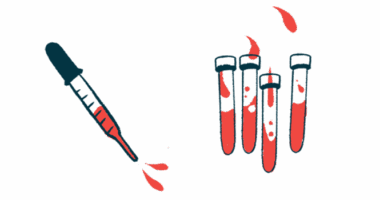Chaperone therapy for Gaucher disease
Last updated April 25, 2025, by Marisa Wexler, MS

Chaperone therapy is an experimental treatment strategy for Gaucher disease that uses small molecules to help stabilize the defective enzyme responsible for the genetic condition.
While no chaperone therapies have been approved to date for Gaucher disease, several molecules have been investigated in preclinical studies and early clinical trials.
What is chaperone therapy?
Naturally occurring proteins, chaperones assist in key cellular processes, such as the correct folding and stabilization of other proteins. Chaperones also act as molecular guardians, ensuring other proteins are not degraded prematurely and are transported to their correct location within cells.
Chaperone therapy is a type of treatment that uses small molecules to mimic the function of natural chaperones. Called pharmacological chaperones, these molecules can bind to misfolded enzymes and stabilize them, helping them to fold correctly and to also reach their proper destination.
Gaucher disease is caused by mutations in the GBA1 gene, which provides instructions for making an enzyme called glucocerebrosidase, or GCase. This enzyme is normally responsible for breaking down a fatty molecule called glucocerebroside, known as Gb1.
In Gaucher disease, GCase deficiency causes Gb1 to build up to harmful levels inside certain cells, ultimately driving disease symptoms such as enlarged organs, blood complications, and bone damage.
To function properly, the GCase enzyme needs to acquire a certain three-dimensional shape and be transported to a specific cellular compartment called the lysosome. Gaucher-causing mutations often interfere with those processes, however. Thus, the goal of chaperone therapy for Gaucher disease is to bind to the misfolded GCase enzyme so that:
- it folds into the correct shape and becomes more stable, which is called enzyme stabilization therapy
- it is efficiently transported to the lysosome, known as lysosomal enzyme targeting.
By restoring some GCase function, chaperone therapy could theoretically address the underlying cause of Gaucher disease.
While this approach has not yet been proven effective for Gaucher, it has shown success in treating other lysosomal storage disorders — including Fabry disease. A chaperone-based treatment for that genetic disorder has been approved by the U.S. Food and Drug Administration (FDA).
Potential benefits of chaperone therapy for Gaucher disease
Because data on the use of chaperone therapy for people with Gaucher disease is still limited, the potential benefits of this approach remain uncertain. However, small clinical studies — most of which tested a chaperone molecule called ambroxol — have suggested that chaperone therapy may be able to:
- increase GCase enzyme activity
- reduce levels of Gb1 and related fatty molecules
- ease fatigue and reduce pain
- decrease the size of enlarged organs, particularly the spleen and liver
- increase red blood cell and platelet counts
- increase bone density
- slow the progression of neurological symptoms.
Most people with Gaucher have type 1 disease, which does not cause neurological problems. But people with types 2 and 3 do have neurological issues, which current FDA-approved treatments for Gaucher disease cannot manage effectively because they are not able to get into the brain.
A potential advantage of chaperone therapy is that it uses small molecules that may reach the brain and ease neurological complications. Data from studies of ambroxol suggest that using this small molecule therapy for Gaucher can slow the progression of neurological symptoms and help improve problems such as abnormal eye movements and involuntary muscle twitches.
Chaperone therapies in clinical development
As of now, standard approaches for Gaucher disease treatment include enzyme replacement therapy, or ERT, which delivers a healthy version of the GCase enzyme, and substrate reduction therapy, which reduces Gb1 production. Both aim to reduce the buildup of fatty molecules that drives Gaucher symptoms.
Chaperone therapy is not yet approved for Gaucher disease, and emerging therapies have mostly been tested in preclinical studies. Only a few pharmacological chaperones have been evaluated in clinical trials for Gaucher disease, with ambroxol having the most clinical data available.
Ambroxol
Ambroxol hydrochloride, which is approved to manage certain cough and cold symptoms, is the most well-studied chaperone therapy for Gaucher disease.
It has been tested in more than a dozen clinical trials and studies in people with Gaucher. While most of these studies were small and used distinct doses and designs, some patients experienced improvements in their symptoms. However, the therapy’s benefits appear to depend on the specific GBA1 mutations a person carries, and even patients with the exact same mutations may respond differently to treatment.
Because no therapies are approved to manage the neurological symptoms of Gaucher, ambroxol is sometimes used off-label in patients with types 2 and 3. It may be given alongside standard therapies or used as an alternative to ERT or SRT when those therapies are not accessible or ineffective.
Potential side effects or complications from chaperone therapy
As with any medication, chaperone therapy for Gaucher disease may carry certain risks and safety concerns, although the potential risks and benefits of this type of treatment are still not fully understood due to limited data.
Still, in clinical studies of ambroxol, reported side effects included:
- upset stomach and abdominal pain
- nausea and vomiting
- diarrhea
- cough
- headache
- allergic reactions.
Gaucher Disease News is strictly a news and information website about the disease. It does not provide medical advice, diagnosis, or treatment. This content is not intended to be a substitute for professional medical advice, diagnosis, or treatment. Always seek the advice of your physician or other qualified health provider with any questions you may have regarding a medical condition. Never disregard professional medical advice or delay in seeking it because of something you have read on this website.
Recent Posts
Related articles



